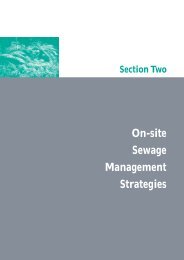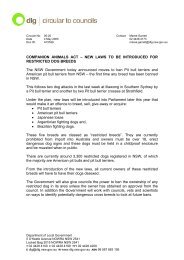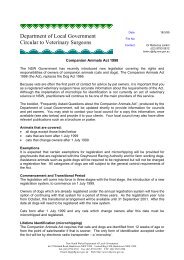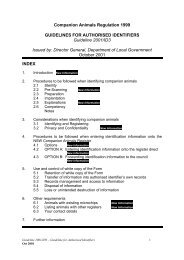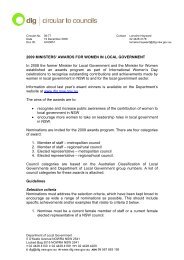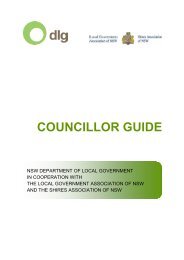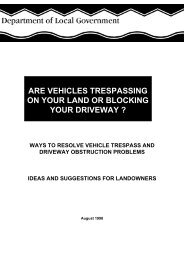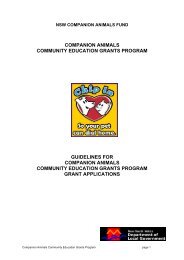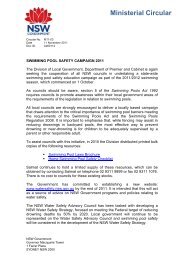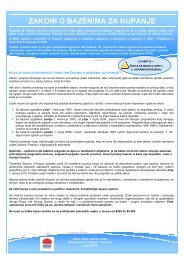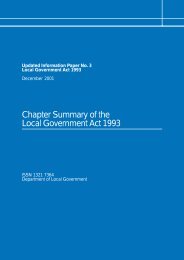Integrated Planning and Reporting Manual - Division of Local ...
Integrated Planning and Reporting Manual - Division of Local ...
Integrated Planning and Reporting Manual - Division of Local ...
You also want an ePaper? Increase the reach of your titles
YUMPU automatically turns print PDFs into web optimized ePapers that Google loves.
3. THE RESOURCING STRATEGY<br />
3.4.2 Asset Management Plans<br />
Essential Element 2.15<br />
The Asset Management Plan/s must encompass all the assets under a council’s control.<br />
Essential Element 2.16<br />
The Asset Management Plan/s must identify asset service st<strong>and</strong>ards.<br />
Essential Element 2.17<br />
The Asset Management Plan/s must contain long term projections <strong>of</strong> asset maintenance, rehabilitation<br />
<strong>and</strong> replacement costs.<br />
Asset Management Plans are long-term plans that outline the asset activities for each service. The<br />
International Infrastructure Management <strong>Manual</strong> (IIMM) defines an Asset Management Plan as “…a<br />
written representation <strong>of</strong> the intended asset management programs for one or more infrastructure<br />
networks based on the controlling organisation’s underst<strong>and</strong>ing <strong>of</strong> customer requirements, existing<br />
<strong>and</strong> projected networks, <strong>and</strong> asset conditions <strong>and</strong> performance” 5 .<br />
Councils may choose to have a single plan that encompasses all the assets under its control, or it<br />
may have a series <strong>of</strong> plans for each asset class or asset group (eg roads, buildings).<br />
As an Asset Management Plan outlines actions <strong>and</strong> resources to provide a defined level <strong>of</strong> service<br />
in the most cost-effective way, it should include as a minimum (core) approach:<br />
the best available information <strong>and</strong> r<strong>and</strong>om condition/performance sampling<br />
a simple risk assessment to identify critical assets <strong>and</strong> strategies to manage those risks<br />
a description <strong>of</strong> existing levels <strong>of</strong> service<br />
long-term cash flow predictions for asset operation, maintenance <strong>and</strong> renewals based on<br />
local knowledge <strong>of</strong> assets <strong>and</strong> options for meeting current or improved levels <strong>of</strong> service <strong>and</strong><br />
for serving the projected population<br />
financial <strong>and</strong> critical service performance measures against which trends <strong>and</strong> Asset<br />
Management Plan implementation <strong>and</strong> improvement can be monitored.<br />
There are specific asset management planning requirements for water supply <strong>and</strong> sewerage. They<br />
require compliance with the Best-Practice Management <strong>of</strong> Water Supply <strong>and</strong> Sewerage Guidelines<br />
2007 <strong>and</strong> the NSW Reference Rates <strong>Manual</strong> for Valuation <strong>of</strong> Water Supply, Sewerage <strong>and</strong><br />
Stormwater Assets. Further guidance for councils is provided in the Water Supply <strong>and</strong> Sewerage<br />
Asset Management Guidelines 1991.<br />
These requirements include the need to prepare an Asset Register, a 20 to 30 year Operation Plan,<br />
Maintenance Plan <strong>and</strong> a Capital Works Plan which identifies the required renewals, works for<br />
improved levels <strong>of</strong> service <strong>and</strong> works for serving new growth. Councils must continue to meet these<br />
asset management planning requirements for their water supply <strong>and</strong> sewerage infrastructure.<br />
5<br />
International Infrastructure Management <strong>Manual</strong>, page 2.39<br />
<strong>Planning</strong> & <strong>Reporting</strong> <strong>Manual</strong> Page 74 <strong>of</strong> 115



